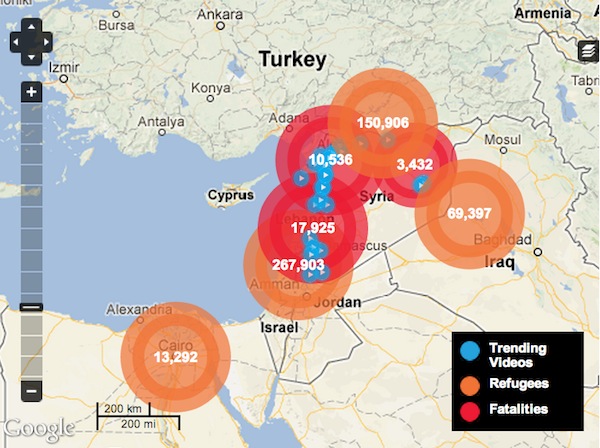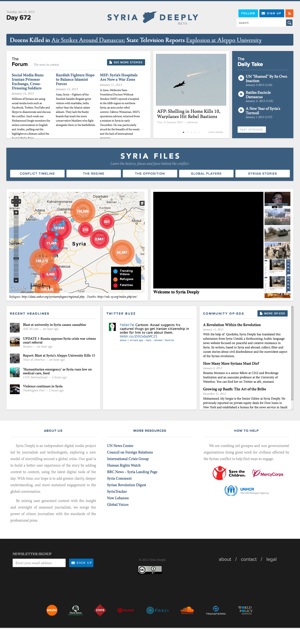
I’m not the first person to launch a single-story website. But I may be the first person who left a cushy TV job to do it.
 Six months ago, I was a correspondent for ABC News and Bloomberg Television, covering the Middle East from our base in Dubai. It is a job I loved, and still love. But most of my time now is spent focused on the Syria story, in a digital redesign of the foreign news experience.
Six months ago, I was a correspondent for ABC News and Bloomberg Television, covering the Middle East from our base in Dubai. It is a job I loved, and still love. But most of my time now is spent focused on the Syria story, in a digital redesign of the foreign news experience.
 As the months of 2012 rolled on, Syria’s Arab Spring uprising descended into all-out civil war. The story was excruciatingly opaque (foreign journalists were heavily censored) and fundamentally complex (it drew on decades of Baath party politics and centuries-old sectarian rifts). It was asking a lot of our news users to grasp it, especially in a mainstream news cycle that doesn’t afford us the chance to provide context, history, or much depth. That is particularly true on foreign stories.
As the months of 2012 rolled on, Syria’s Arab Spring uprising descended into all-out civil war. The story was excruciatingly opaque (foreign journalists were heavily censored) and fundamentally complex (it drew on decades of Baath party politics and centuries-old sectarian rifts). It was asking a lot of our news users to grasp it, especially in a mainstream news cycle that doesn’t afford us the chance to provide context, history, or much depth. That is particularly true on foreign stories.
I saw an audience of people thirsty to understand more. It was a niche audience, perhaps, but it was there. And it was vastly underserved.
From that, I was driven by a deep consumer need and a profound personal mission to build Syria Deeply, a platform that fuses journalism and technology to better cover a complex story. It is part news aggregator, part interactive backgrounder, part original reporting space. Most importantly, it aims to fuse all of the kinds of content that have become critical to this crisis: professional reporting, citizen journalism, and social media. We wanted to visualize more, convey greater nuance, and focus on civilian stories, rather than just emphasize the big shots and the battle action that normally lead our headlines.
As I was building the model, from a hand sketch in my notebook through to a working prototype, it was clear this was a platform that could grow. I imagined that as we continued to hone the model, we could apply it to other complex issues. We launched, gratefully, to reviews that we had outsmarted the news and redesigned crisis coverage. In the weeks that followed, we saw a movement of people interested in expanding our model, to new geographies (Iran Deeply, North Korea Deeply, Pakistan Deeply) and broader complex issues (Cancer Deeply, Drug War Deeply, Euro Debt Deeply).
Since the launch of Syria Deeply a little over a month ago, Syria Deeply has had a steady flow of visitors, 80 percent of whom are English speakers and who are predominately from the U.S and Europe. We have had a 48 percent return rate with an average visit duration of 2:10 minutes, which shows that our readers consistently find value in our site and return to stay up with the crisis. Naturally, being part of the social media age, the large majority of our new visits have been referred through our Facebook and Twitter pages rather than through search, with a good amount of those new visits directed to the conflict timeline and our infographics, which serve as introductory tools to people wanting to learn more about the fundamentals of the Syrian crisis.
In the future, we’ll expand the single-story model, essentially serving as news R&D, toward optimizing more sophisticated delivery for sophisticated content. As with all startups, it’s on us to mange our growth — choosing how to scale at the right time, with the right partners, on the right subjects. Meanwhile, here’s what I’ve learned so far from the single-story model and what I think it says about the future of news, in 2013 and beyond.
Single-topic platforms, such as Syria Deeply, are not made up of a team of journalists and editors reporting to a passive audience. Instead, they embrace participatory journalism in which civilian journalists can collaborate and contribute to the news process with personal stories and firsthand accounts. As a platform, we are then able to aggregate and curate the most useful content on that topic into one space.
That does call on the journalist to serve a stronger curatorial function. Columbia’s “Post-Industrial Journalism” report summarized it nicely: “The journalist has not been replaced but displaced, moved higher up the editorial chain from the production of initial observations to a role that emphasizes verification and interpretation, bringing sense to the streams of text, audio, photos and video produced by the public.” That is what we’ll aim to do, issue by issue.
Single-topic platforms can serve the deep domain expert and capture the interest of the topical dilettante. The idea is to capture people at their level of knowledge and help lift them to a greater understanding. Background can be made interesting. Historical content can be made engaging. Personal stories — civilian stories — can add texture and enhance interest in the macro picture of what’s going on. At Syria Deeply, we put background elements like a Conflict Timeline and Regime Map alongside news of the day which, as previously mentioned, is drawing readers who are perhaps unfamiliar and new to the Syria crisis. Those background elements add context to content, and adds value to the news user’s overall experience.
Working on a fundamental redesign of the news, at the story level, gives us the opportunity to put the user experience first. We design for it and we program for it, as we look for ways to engage, inform, and delight people. Since we’re building on the mandate to serve the niche, those interested in getting smart on an issue, we can stay within that mission and still innovate wildly, in service of the end user.
While we iterate toward the best possible user interface, we already know we are providing a experience that is fundamentally different that what’s in the news marketplace. Our audience, like our reporters, gets pulled left, right, and center across a flurry headlines ranging from troops leaving Afghanistan to the latest move toward a fiscal cliff.
The story-specific platform is a relief: profound by the nature of our content, calm by the focus of our mandate. Do one story well and filter out the noise. Spread knowledge and build a relationship with the user, based on how well you serve them. We have had the luxury of starting from scratch. But there are lessons even the big guys can learn from our model. For the sake of an informed public, I hope they do.
Lara Setrakian is co-founder and managing editor of Syria Deeply. She has been a foreign correspondent for ABC News, Bloomberg Television, the International Herald Tribune, and other outlets.